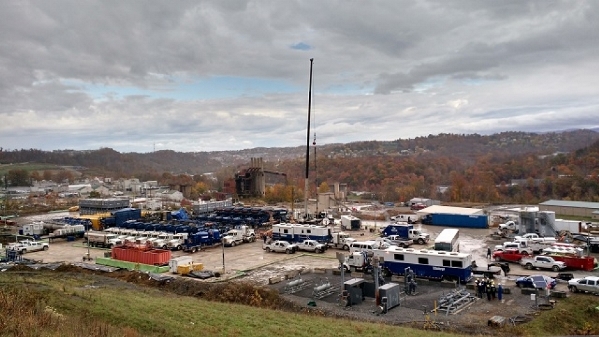 By Ben DuBose on 7/31/2017 2:19 PM
By Ben DuBose on 7/31/2017 2:19 PM

Researchers studied oil and gas wells in the Utica Shale region of the United States for the presence of corrosive sulfides. Photo courtesy of Rebecca Daly, The Ohio State University.
Many modern tests focused on the detection of sulfate-reducing bacteria (SRB) as corrosive agents in U.S. shale infrastructure could be missing a separate bacterial family also responsible for toxic, corrosive sulfides, according to a case study1 conducted by researchers at several major institutions.
In the study published this year, researchers at The Ohio State University (Columbus, Ohio), West Virginia University (Morgantown, West Virginia), and the U.S. Pacific Northwest National Lab (Richland, Washington) decided to track sulfur cycling catalyzed by the microbial community in a hydraulically fractured well in the Utica Shale formation near Flushing, Ohio.
“The well continually pulls up fluids that have been sitting in the fractures for months, so it’s a good way to get a chemical and biological look at what’s going on down there,” says Mike Wilkins, an environmental microbiologist at Ohio State and senior researcher on the study.
Based on their findings, the researchers believe the oil and gas industry may need to adopt new methods of monitoring and mitigating sulfide-producing bacteria in fractured shales.
How Fracking Influences Microbial Environment
The “fracking” process involves high-pressure injections of water, sand, and chemicals to create fracture networks that release oil and gas, which are pumped back to the surface and recovered. According to Wilkins, since this process has only taken off in the past decade, not much is known about the microbial ecosystems in these networks.
“This is a pretty inhospitable environment of high pressure, salinity, and temperature some 2,000 meters underground,” Wilkins explains. “The industry spends a fair amount of money trying to keep microbes out of these systems.”
These sulfide-producing microbes can cause a number of problems for drilling operators, including the corrosive degradation of metal pipelines and toxic exposure to workers on the drilling pad. Hydrogen sulfide (H2S) can also “sour” a well, Wilkins says, noting that H2S must be separated from oil and gas in an expensive process. Furthermore, the microbes themselves can gum up the extraction process by filling in tiny fractures with either biomass or excreted precipitates, he adds.
In metallic pipelines, this microbiologically influenced corrosion (MIC) is most frequently seen in the form of localized pitting.
Case Study Results
Wilkins’ team had previously found that one bacterial family in particular, Halanaerobium, was particularly present in fractured well ecosystems. These bacteria can convert thiosulfates found in the well environment to sulfide, in contrast to SRB—which convert sulfate to sulfide.
Within 10 days after the pumping and sampling of well fluids had begun, the researchers found the Halanaerobium family had reached nearly 100% dominance within the bacterial community and remained so for the next 100 days.
The researchers then examined the genes present to find enzymes that might be capable of catalyzing sulfur reactions. In doing so, they found multiple copies of rhodanese—an enzyme that can reduce thiosulfate to sulfite and elemental sulfur. They also discovered multiple copies of anaerobic sulfite reductase, an enzyme that reduces sulfite to sulfide. With these two enzymes together in the well environment, it would be possible to convert thiosulfate to sulfide, Wilkins explains.
To confirm this, the researchers cultured Halanaerobium isolated from well samples. In their test, the lab-grown bacteria produced both enzymes. And when fed thiosulfate in the culture, sulfide was produced. The team also measured a particular sulfur isotope that microbes prefer to consume and found that it decreased in the well samples over time.
“That’s a sign that the sulfur cycling seen in this well is a microbial process, rather than an abiotic one,” Wilkins says.
Problems with Existing Industry Tests
But according to Wilkins, most current industry tests monitor for these microbes by only searching for SRB activity. “Sulfate-reducing bacteria [SRB] are super common in seawater and groundwater and convert sulfate to sulfide,” he explains. As a result, efforts are frequently made to ensure that low-sulfate fluids are used for fracking injections.
In the Utica case study, however, no evidence of SRB was found in the data sets. Based on that, Wilkins says many existing industry tests could mistakenly lead a well operator to think that no sulfide was produced. In reality, of course, the researchers found the Halanaerobium bacteria—not SRB—had led to the formation of sulfides.
“Knowing which microbes are doing potential damage is important so that well operators can target them better,” Wilkins says, adding that the Halanaerobium family has been found in fractured well ecosystems from Texas to Pennsylvania.
Funding for the study was provided by the National Science Foundation (Arlington, Virginia) and the U.S. Department of Energy (Washington, DC).
Source: American Society for Microbiology, www.asm.org. Contact Mike Wilkins, The Ohio State University—Email: wilkins.231@osu.edu.
Reference
1 A.E. Booker, et al., “Sulfide Generation by Dominant Halanaerobium Microorganisms in Hydraulically Fractured Shales,” mSphere 2, 4 (2017).
